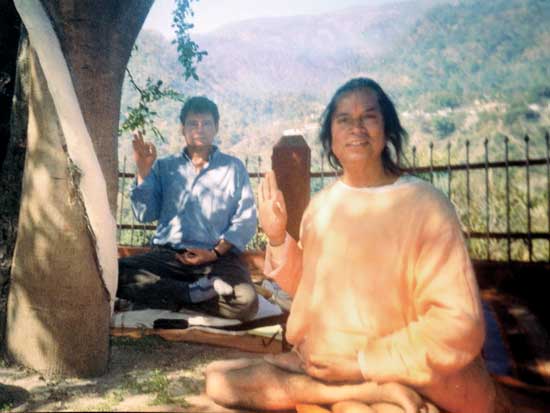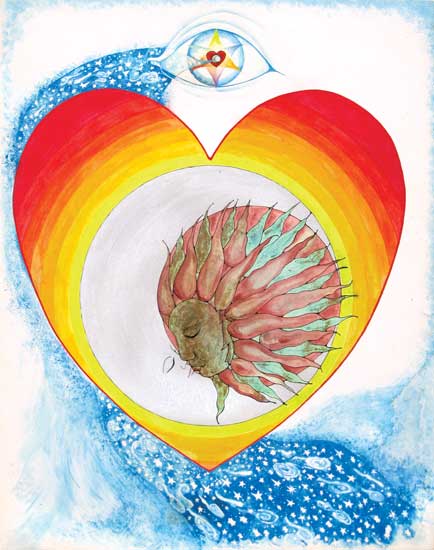Meditation Retreats
Finding the Mind’s Nine Bodies – Utne

1 / 2

Balyogi would sometimes have him sit and meditate under a Bodhi tree or lie under several sala trees by his ashram, which overlooked the Himalayan Mountains and Ganges River.
Photo courtesy of Phillip Moffitt
2 / 2

Balyogi used illustrations to show the nine levels of consciousness as he described and mapped experiences that arise at each level.
Image courtesy of Phillip Moffitt
❮
❯
Phillip Moffitt first became nationally visible as owner and editor of Esquire magazine, rescuing it from debt in the 1980s. But that feat, he believes, resulted from his real calling, which emerged at nap time when he was 3. “Rather than sleep, I played a game where I tried to think of nothing. I’d lie there and think I succeeded but wasn’t sure,” he recalled of his early life in the Appalachian Mountains of east Tennessee. “I never told adults what I was doing.”
Twenty years later, he visited an ashram in the Bahamas, where Swami Vishnudevananda was giving people mantras. Moffitt wanted one too and thought he was ready. He had been there several times before. “But Vishnudevananda said, ‘No mantra for you. You just empty your mind and think of nothing.’ I thought he meant my mind was too scattered,” Moffitt recalled. But later he realized the guidance was apt. Meditating that night, he found himself quite able to empty his mind and “think of nothing.” He had, after all, begun practicing when he was 3.
That inner vigilance also uncovered his and other men’s deeper concerns, he says, shaping the editorial direction at Esquire that reinvigorated the magazine. Being able to distinguish nine meditative states and describe how to attain them, as he does in his new book, Nine Bodies, also can be traced to the inner adventures he has now pursued for six decades. The book’s focus on altered states diverges from his previous books, Emotional Chaos and Dancing With Life, which examined how Buddhist teachings can be applied to daily angst.
However, Moffitt left the angst of running a magazine decades ago. In 1986, he sold Esquire to explore consciousness full time. These days he lives in northern California and leads Buddhist Insight Meditation retreats at Spirit Rock and other meditation centers around the U.S. He also does what he describes as “change and transition counseling for leaders” at his Life Balance Institute. “Developing intuition is a big concern for executives,” Moffitt observes. “They always want to know how to access intuition, what you can’t get from data.”
Identifying authentic intuitions has been pivotal for Moffitt. Coming from humble beginnings, he and a business partner acquired Esquire in the course of risky venture capitalism before it was common. Determining the moment to exit his New York life among the literati required another crucial intuition. “It was a great life, being editor and CEO of Esquire,” working with such writers as Gay Talese, Tom Wolfe, and Truman Capote, and influencing discourse on big issues, he said. He chose to be CEO as well as editor-in-chief at Esquire so he would have no boss. “But I’d get defined by pressure, sucked into gain, loss, and people counting on me,” he said, “not the open feeling defined by meditation.”
For four years, as he approached 40, he told friends he would be leaving Esquire to pursue the meditative life that intrigued him. He had been studying yoga and Buddhism for years before it became popular and often visited India, where he spent time with yogis and Buddhist masters. Finally, near his 40th birthday, with Esquire prospering, he was sitting in an Association of Magazine Editors meeting when he realized he could continue that life for another decade, but would regret it. “Windows of opportunity to act sometimes open again, sometimes not,” he said.
He left the room to make a phone call to a friend who would connect him with an investment banker. Promptly, on the last day of 1986, Esquire was sold, and Moffitt soon left New York for California. “At 40, the beginning of society’s peak period for accomplishment, from 40 to 60, I left Esquire. I chose the inner life, at big financial sacrifice,” says Moffitt. “I knew what making it in the world was like, but I didn’t want to worry about what it would have been like to give myself to the inner life.”
He recalled how reporters from the New Yorker, Vanity Fair, and the New York Times pursued him, seeking the secret cause of his departure, but never wrote stories about it, as no secret lurked. “I only missed that life when society went the wrong direction politically, and I wanted Esquire’s national voice,” he said.
What led him to the Nine Bodies teachings was another “intuition” several years later, soon after he began teaching at Spirit Rock. He was in India, visiting Bodh Gaya, where Buddha was said to have become enlightened. At a friend’s suggestion, he went on to Rishikesh to see Sri Swami Balyogi Premvarni for help with a constriction in his throat. Balyogi took Moffitt aside and gave him a mantra — 30 years after Vishnudevananda had refused him one.
Moffitt notes the irony of asking for a mantra from a teacher in the Bahamas and so long afterward receiving one from a teacher in Northern India. They were both yogis in the Hindu forest tradition and had been close friends, though the first was long dead when Moffitt met the second. Moffitt points out that while Buddhism, the basis of his practice, focuses on freedom from suffering, Hinduism explores meditative states that have fascinated him since his early naps.
Balyogi addressed Moffitt’s throat issue, and then Moffitt took a 20-minute tour of the ashram. He was ready to leave when Balyogi, standing with him at the top of a hill, said, “You can’t leave.”
“I had no reason to place my trust in him, no reason to give up my schedule, and it was a hassle to change it,” said Moffitt. “I was not looking for a teacher. This wasn’t exciting. I had little motive to stay. But I had to decide right then about the train. I realized this might be another window of opportunity that might not open again. My intuition said, ‘Be available,’ not, ‘This is right.’ People have less access to intuition if they think it comes as, ‘I know this is the right thing.’ Intuition is more subtle than that.”
Moffitt stayed with Balyogi for three days, and Balyogi introduced him to the Nine Bodies teachings. “Someone who had been there waiting for years for those teachings left in a huff,” Moffitt recalled.
Balyogi used illustrations to show the nine levels of consciousness as he described and mapped experiences that arise at each level, Moffitt said. “I had those experiences but no map before. In Buddhism, we’re interested in the distinction between suffering and non-suffering and choosing non-suffering. Buddha said, ‘I teach suffering and the end of suffering,’ not altered states,” says Moffitt. “Hinduism is more about experiences along the way, more interested in energetic states.”
Moffitt returned many times, and then Balyogi told him, “You need to write a book.”
“That took me 14 years, because I wasn’t steeped in his tradition, and his teaching style was nonlinear and hard to track,” says Moffitt. “He would digress and then come back to a topic. He might talk about the difference between the ‘knowing of knowing’ and the ‘knowing of being.’ For years, I’d have to reconstruct the levels over and over. What is the experience of it? If we’re reflective, we’ve had these experiences, but with no name for it. Thinking about it altered my consciousness.”
Balyogi’s teaching style was not conceptual but rather more of a “transmission,” Moffitt says.“Others are brilliant at passing down concepts. He had access to genuine knowledge that leads to understanding and insight at a subtle level of experience.”
To gather material for the book, Moffitt visited Balyogi once a year for eight years, staying two weeks each time. He stayed in Rishikesh hotels to experience the city while giving Balyogi a break from his questions.
Balyogi would sometimes have him sit and meditate under a Bodhi tree or lie under several sala trees by his ashram, which overlooked the Himalayan Mountains and Ganges River. “The sounds and smells of India wafted up,” he said. Gangs of monkeys sporadically marauded, chased away by Balyogi with an air gun. One nimble monkey snatched a bag of fruit from Moffitt’s hand that he had brought Balyogi as a gift. Elephants too sometimes passed through, not to be dissuaded.
Balyogi also had Moffitt sit in a cave or by the river or in a boat on the river. “I’d sit there, never knowing for how long or why he didn’t come to get me,” says Moffitt. “Balyogi would interrupt an important point he was making, get up and walk away for 10 minutes or two hours and sometimes not come back to what he had been saying for days. I was constantly tested in my sincerity.”
Moffitt recalled being left meditating deep in a long cave. As he sat, Balyogi gave him a sardine-size can and told him not to open it. “I heard him leave, and I was left to my own interpretation,” Moffitt said. “Spiritual tourists” passing through the cave stepped on his feet, but he continued to sit.
Later, on the Ganges River bank, Balyogi revealed the can to contain an agitated scorpion. He had caught it in the cave near oblivious meditators and then freed it by the water. Two days after the scorpion incident, Balyogi explained that the scorpion was like the ego, struggling on the way to its rightful place.
This erratic relationship challenged Moffitt’s need for reliable order. “I like to understand the operating rules, so I can have integrity with myself and the culture,” he said. “But I know it was frustrating for him that I didn’t follow the guru model. Mutually we made many accommodations. Any student of the inner life holds responsibility for themselves while honoring larger human knowledge.”
Whether because of or despite Balyogi’s habits, following his direction led Moffitt to experiences of the Nine Bodies that informed his writing about them. “He created conditions for altered states to arise, but it’s not a parlor trick,” says Moffitt. “He would talk about a body, then move on to something else, not in order. He also jumped from one illustration to another. He talked about a picture a little. Then he’d talk about it later. You learn to shift your mind, and learn in a different way.”
Balyogi’s paintings, Moffitt found, reflected and were conducive to the meditative states Balyogi described. In Balyogi’s art, human bodies contain the universe in multiple and mirrored ways. In the painting, Eye of Awareness, an eye contains a heart containing a sun in a sphere, which turns out to be the moon kissing the sun, and the whole image recurs in miniature. In Cosmos in Repose, a person is part of an ocean that flows into his torso as a river running through a town and landscape, bordered and shaped by a rainbow. In Balyogi’s art, the human is cosmos and also immersed in it.
Moffitt took notes as Balyogi talked and also recorded him, then repeatedly reviewed the material to be able to articulate and make “trackable” the information so diffusely presented. Repeated attention to descriptions of the Nine Bodies elicited the altered states themselves, he found.
In nine bodies, Moffitt gives order to the information, as the “bodies” cluster in groups of three at three levels. An experience of one gives access to experiencing another. For instance, meditators can know they experienced the first “body,” the Physical Body, when they can feel sensations of breathing without inner comment or control, Moffitt says. Experience of the second body, the Vital Body, may begin with the first, but leaves that behind for another kind of occurrence.
Like Balyogi’s digressive presentation, experience of the Bodies may not occur sequentially. Moffitt observes, for instance, that traumatic history predisposes some to the Astral Body, a vehicle for out-of-body experiences.
What Balyogi calls the Etheric Body, which is fourth, transcending the physicalities of the first three, was familiar to Moffitt, although he had never defined and named it. “I’d been reliant on it for my development,” he said.
However, the ninth, the Cosmic Body, “lacks even a perfume,” he writes in Nine Bodies. “You can only infer its existence” via the eighth body, the Divine Body, he says. “It’s the source of mysterious energy that underlies all awareness. It’s what generates the ‘electricity’ of consciousness. But in rare moments of meditation you experience directly the aliveness of empty awareness.”
Jessica Cohen is a freelance writer based in New York.
Published on Jun 12, 2018
RELATED ARTICLES
Create wealth equality and define the middle class by leveraging new technology while deploying economic systems free from discrimination.

Achieve racial equity through checks and balances a blockchain network provides by connecting everyone as nodes while still providing anonymity.

Learn about the beginning of Silicon Valley’s Libra Project and its narrow attempt at the makings of cryptocurrency of the future.






